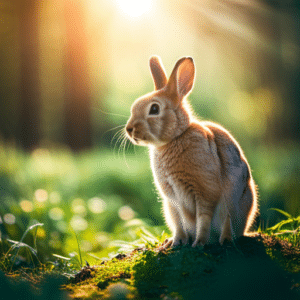When we think of fluffy creatures hopping around the meadows, rabbits, and hares often come to mind. But did you know that despite their striking physical resemblances, hares and rabbits are distinct and separate species with unique characteristics? This article aims to delve into the differences between the two, including their physical attributes, habitats, and dietary habits.
short summary
Hares and rabbits, though physically similar, have distinct characteristics. Hares are leaner, faster, and prefer open spaces, while rabbits are social creatures that prefer covered areas.
The life cycles of hares and rabbits differ considerably. Hares are precocial, born mature and independent, while rabbits are altricial, needing parental care after birth.
Human activities pose significant threats to both species – habitat destruction, hunting, and viral diseases. Conservation efforts focus on habitat protection and awareness raising.
A clear understanding of the differences between hares and rabbits helps us interact appropriately with these creatures and contributes to their conservation.
The Key Differences Between Hare vs. Rabbit
Hares and rabbits, both belonging to the family Leporidae, differ in several ways. Hares are generally larger and possess longer hind legs and ears. Unlike the baby rabbits, however, hares are born fully furred, with eyes open, and are capable of hopping around soon after birth.
Rabbits, on the other hand, are altricial – meaning newborns are helpless, hairless, and blind. They are born into a protected nest called a warren and require parental care for survival during the early stages of life.
Where do Hares Live and What Do They Eat?

Hares are widespread across the world, with populations thriving in Africa, Asia, Europe, the Americas, and Japan. They prefer open areas such as prairies, fields, and meadows where their long, powerful hind legs are best utilized for outrunning predators.
As for their diet, hares are primarily herbivorous, feeding on grasses, herbs, and occasional fruits. Unlike rabbits, hares have been observed eating meat and animal remains, particularly in winter when plant-based food is scarce.
How to Tell the Difference Between a Hare and a Rabbit
Distinguishing a hare from a rabbit can be a delightful and intriguing challenge. Start by carefully observing their size and physical characteristics – hares are generally larger in size, boasting longer ears and more robust hind legs. Additionally, hares tend to have longer legs and a leaner body structure compared to rabbits. When it comes to habitat preferences, hares are typically found in open fields or grasslands, where their incredible speed and agility can be fully utilized. On the other hand, rabbits tend to seek areas with plenty of cover, such as thickets or shrubbery, where they can easily hide from predators. Lastly, let’s not forget about their behavior – hares are often solitary creatures, known for their more aggressive nature, while rabbits are frequently observed in groups, displaying social behavior and a tendency to burrow into the ground for safety. By paying attention to these subtle differences, you can become an expert in distinguishing these fascinating creatures with confidence.
Understanding the Lifecycle of a Hare Compared to Rabbit
The lifecycle of hares and rabbits is also quite different. While both species can breed quickly, with gestation periods ranging from 28 to 42 days, the development process after birth varies drastically. As mentioned earlier, baby hares are precocial animals – meaning they are born relatively mature and independent. They are capable of hopping around shortly after birth and require minimal parental care for survival. On the other hand, rabbits are altricial animals – meaning newborns need parental care and protection to survive their early stages of life.
Although hares and rabbits share many physical similarities, they have distinct characteristics that set them apart from each other. By comparing subtle differences, you’ll be able to recognize a hare or rabbit from afar and understand their unique behaviors. So the next time you spot a furry creature hopping across the grass in your meadow, take a moment to observe it carefully – chances are you’ll be able to identify whether it’s a rabbit or hare!
Exploring the Behavioral Differences between Rabbits and Hares

Hares and rabbits also differ in their behavior. Hares tend to be solitary creatures, while rabbits prefer to live in colonies or small groups. Considering the large size of hares compared to other members of the family Leporidae, they are more aggressive and territorial than rabbits.
Also, it’s important to note that when threatened, hares will typically flee, whereas rabbits are more likely to stay in one place or hide.
Conservation Efforts and Threats to Rabbits and Hares
Human activities, such as urbanization and industrialization, have resulted in the destruction of habitats for many species of mammals, including hares and rabbits. Additionally, both species are hunted for their meat and fur. Furthermore, wild rabbits are prone to fatal viral diseases which can spread rapidly in a population if not controlled properly.
The best way to protect these gentle creatures is by raising awareness of their conservation and supporting local initiatives that protect habitats. Knowing the key differences between hares and rabbits is also an important first step to understanding why they are so important to our ecosystems. By being mindful of these small creatures, we can do our part in preserving populations of hares and rabbits for generations to come.
Avoiding Common Misconceptions about Rabbits and Hares

Despite their physical likeness, hares and rabbits are two distinct species. While many people assume that they share the same characteristics, this is not the case. Being aware of the differences between these creatures can help us better protect both species and their habitats. Moreover, understanding what is the difference between rabbits and hares and how their behavior differs can also prevent misconceptions from occurring in our day-to-day interactions with them. For instance, a hare’s tendency towards aggression should be taken into consideration and handled accordingly.
Frequently Asked Questions
Are Hares Faster Than Rabbits?
Yes, hares are generally faster than rabbits. Their long, powerful hind legs are adapted for high-speed evasion from predators.
Is a hare just a wild rabbit?
No, a hare is not a wild rabbit. Hares and rabbits are two distinct species belonging to the family Leporidae. They differ in several ways, including physical attributes, habitats, and dietary habits.
Do Hares and Rabbits Live Together?
Typically, hares and rabbits do not live together. Hares prefer open spaces and do not burrow, while rabbits often live in burrows or warrens.
Can Hares and Rabbits Crossbreed?
Crossbreeding between hares and rabbits is rare and typically unsuccessful due to differences in their number of chromosomes. The genetic differences between the two species are too great for successful interbreeding.
Do Hares Hibernate in Winter?
No, hares do not hibernate. They are well-adapted to cold climates and can find food even in the snow.
Is Bugs Bunny A hare or a rabbit?
Bugs Bunny is a fictional cartoon character and is not related to either hares or rabbits. He often displays characteristics of both species, however, such as agility and cleverness.
Conclusion
Hares and rabbits are two wonderful species belonging to the same family, the family Leporidae. Although they share certain physical similarities, it is important to remember that they have distinct characteristics that set them apart from each other. By observing and appreciating these subtle differences, we can better understand and protect both species. Being mindful of their behavior can also help us avoid common misconceptions about hares and rabbits, ensuring that other species and their habitats are preserved for generations to come.



